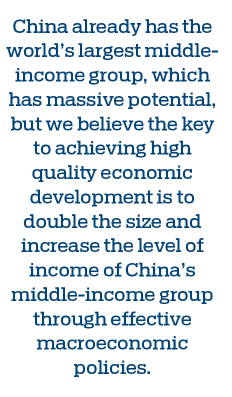Expanding the potential of consumption
Doubling the size of China's middle-income group in the next 15 years would ensure sustainable economic development
Thanks to the supply-side structural reform rolled out in 2015 in China, there has been effective economic restructuring to correct the distorted allocation of production elements and improve supply efficiency. But continued structural optimization and transition requires the establishment of a bigger middle-income group.
To ensure sustainable economic development, it is important to let the middle-income group in China to play a stronger role in consumption and demand upgrading.
China already has the world's largest middle-income group, which has massive potential, but we believe the key to achieving high quality economic development is to double the size and increase the level of income of China's middle-income group through effective macroeconomic policies.
There is no universal definition for what constitutes a middle-income group, and three main approaches are adopted internationally.
The most commonly used is the median income approach. The second approach uses the range of the distribution of a country's domestic income. The third approach, used by the World Bank, provides estimates based on global income distribution. According to this approach, the middle-income group is defined as those adults with a daily cash income of $10-$100, that is, $3,650-$36,500 per person per year.
Per the World Bank's method, China's middle-income group is defined as those with an annual income of 25,000 yuan ($3,607) to 250,000 yuan. However, the National Bureau of Statistics of China uses a different calculation method based on China's economic realities and distribution of people's incomes. It defines a middle-income household as a typical family of three people with an annual income ranging from 100,000 yuan to 500,000 yuan. Based on this standard, the size of China's middle-income group surpassed 400 million in 2017.
To bring another 400 million people into the middle-class group based on previous research, if household disposable incomes increased at an annual rate of 6 percent over the next 15 years starting from 2018, in other words, three five-year plan periods, the goal of doubling the middle-income group would be realized.
In this context, we can further map out the demographic distribution of the new middle-income group based on the China Labor Force Dynamic Survey 2016 and China Household Finance Survey 2013. Geographically, among these additional 400 million people, 74.2 percent will come from rural areas and 25.8 percent from urban areas. Age wise, 50.5 percent will be over the age of 45, 17.8 percent will be aged between 26 and 35 and 23.8 percent aged between 36 and 45. That said, residents yet to be urbanized will be the pillar of the new middle-income group, especially migrant workers seeking job opportunities in the first-and second-tier cities.
To this end, we have made the following policy proposals based on the current economic realities of China.
First, we propose relaxing hukou, the household registration system, in the first-and second-tier cities as part of efforts to accelerate the progress of urbanization. The rural residents to be urbanized, especially young people, constitute the main force of the new middle-income group. Without hukou restrictions, they will have a stronger willingness to spend money and make investments in cities. This can also secure a stable source of labor, which is essential for new round of urbanization.
Second, we propose giving proper consideration to reducing personal income tax and social security deductions for the newly registered urbanites and migrant workers in the first-and second-tier cities. This will boost their consumption capability with more income at their disposal. Moreover, young people should have access to further training opportunities to develop vocational skills. This will further enable them to get higher paid jobs and enhance their bargaining power.
Third, we propose leveraging the synergy of cities at different tiers to elevate the income level and ensure the sustainability of the third-and fourth-tier cities, such as the regional integration campaigns for the Beijing-Tianjin-Hebei Region, the Yangtze River Delta, and the Guangdong-Hong Kong-Macao Greater Bay Area. These peripheral cities can benefit from the economic development of the first-and second-tier cities in terms of economic development and industrial upgrading. Meanwhile, the metropolitan areas can leverage the advantages of their surrounding cities, which can provide lower living costs and diverse civic resources. The dynamics generated by the interactions among these cities will inject impetus into the third-and fourth-tier cities, ensuring higher household disposable incomes and better lives for local residents.
To conclude, we believe the benefits of structural reforms and quality economic growth will be broadly and deeply felt as the middle-income group in China keeps expanding. China will continue to offer excellent potential as the world's largest consumption market.
Li Daokui is chief economist with the New Development Bank. Li Keaobo is executive vice-president of the Academic Center for Chinese Economics Practice and Thinking at Tsinghua University. The authors contributed this article to China Watch, a think tank powered by China Daily. The views do not necessarily reflect those of China Daily.















